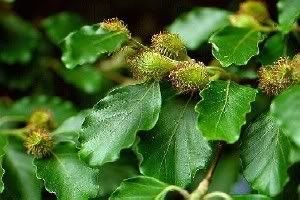

Beech (Fagus sylvatica, F grandifolia)
Folk Names: Bog, Bok, Boke, Buche, Buk (Russian), Buke, Common Beech, European Beech, Faggio, Fagos (Greek “to eat”), Faya, Haya, Hetre; F grandifolia - American Beech
Description: The Beech is native to the forests of central Europe. It prefers light soils, well drained and sometimes alkaline. The tree will grow up to 110-150 feet. The dense, spreading crown forms a distinctive oval. The bark is light ash-gray with horizontal bands, and it often has whitish patches due to lichen. The wood is rose-colored. The shiny leaves are oval, elliptical, and entire though slightly toothed. These turn brownish-yellow or red-brown in the autumn and sometimes stay on the tree till the end of winter. The stamens bearing male flowers are grouped in round stalked catkins, while the females grow in pairs within a cupule. The ripe cupule contains two nuts called beech-mast, but the tree will not even bear fruit until its fiftieth year.
The American Beech prefers moist, loamy soils. It only grows from 80 to 115 feet, though it sometimes reaches 130. It can be found from Nova Scotia to Ontario, south to Florida and eastern Texas, and west to Wisconsin and Missouri. The crown is pyramidal and it has a massive trunk with radical suckers. The bark is thin and smooth, light gray to gray-blue. The alternate ovate-oblong leaves are medium sized with a coarsely toothed margin and pointed tip. They may be two and one-half to five and one-half inches long. Each new leaf is hairy at first, then bright bluish-green on the upper side and pale green below. The leaves are both larger and narrower than its European cousin. The yellowish flowers appear April to May, with triangular fruits arriving in September or October. These are covered by reddish pericarp, a one to three inch husk called a cupule which splits into 4 woody lobes covered by long spines. The inside of the cupule is glossy and furred.
Effects: gentle
Planet: Mars, Saturn Zodiac: Sagittarius, Virgo
Element:
Associated Deities: Diana, Fagus, Itchita
Traditions:
The Yakuts of Siberia believe the triple goddess Itchita, descended from the primary goddess, lives within the Beech tree. She is invoked for protection, and acts as a guardian of devas, though she has an affinity for all nature spirits.
A beech grove on the Alban Hills was sacred to Diana.
Beech and apple were once burned in fires maintained on Lent.
The beech corresponds with rune nyd or nauthiz.
Magic:
The wood of beech is excellent for wish-magic. Carve or scratch a wish into a stick and bury it for a simple spell. The Russian name, Buk, is pronounce ‘book.’ Most names for this tree, including its most common name, mean book, and writing tablets were once made from its wood. Carry the wood, leaves, or nuts to increase creativity, or place a leaf between the pages of a book or diary.
The leaves, bark, and powdered wood are used in protective rituals. It is especially protective against lightning and snakes. The wood may also be dried and powdered as an incense to make your garden more receptive to Devas. It is ideal at Midsummer to make contact with the faerie realm.
Known Combinations:
none noted
Medical Indications: (Caution: large doses of nuts may be poisonous)
Parts Used: bark, leaves, root
The beach is astringent and antiseptic. The Rappahannock Indians steeped the bark in salt water for a poison ivy lotion. The bark was also used in ointments for burns, sores, and skin ulcers. A decoction of the root or leaves was proscribed for intermittent fevers, dysentery, and diabetes, and the oil was used for intestinal worms. It has also been used to treat bladder, kidney, and liver problems. In Kentucky, beech sap was used in a syrup for tuberculosis.
Nutrition:
The nuts, raw, dried, roasted, or ground to flour, were once an accepted substitute for coffee beans. In the South, emerging leaves may be used as a potherb. The oil from crushed kernels is used as cooking oil, and as butter in Silesia, while the raw nut is fit for humans and wild life. In times of famine, the inner bark was dried and pulverized to flour or sawdust might be boiled in water and then roasted. These were then mixed with flour for bread to make it stretch farther.
Mercantile Uses:
Beech wood is widely used in carpentry and flooring for its color. Though the wood is short grained and brittle, it is used for furniture, crates, and tool handles, areas where durability and strength are not necessarily the goal. Unfortunately, burrowing beetles seem to prefer the wood. It is therefore not a good wood to have about if you know you have a beetle problem in your area. The wood is also burnt to make charcoal for color manufacturers and gunpowder. It is also an excellent fuel in heating, surpassing most other woods.
Beach is extremely environmentally friendly. The extensive root system assists in the aeration of the soil, and the amount of potash in the leaves preserve the productive capacity of soils in which it is planted. This also leads to the improved growth of any trees planted with them. A live fence of beech is also useful for the gardener as the leaves generally remain on the trees through the winter, screening young plants.
Beechnuts are used in many countries to feed livestock and are especially liked by pigs. In England, the nuts are reserved for the feeding of park deer. Cattle may be feed on the cakes left from nuts pressed for oil. Horses should not be given beechnuts however.